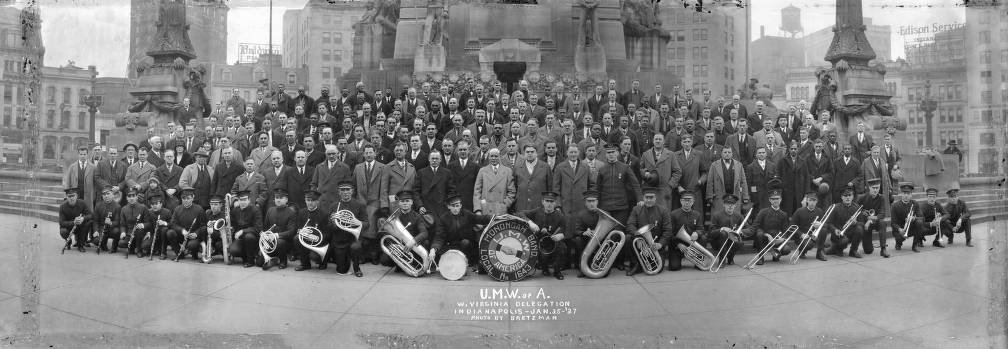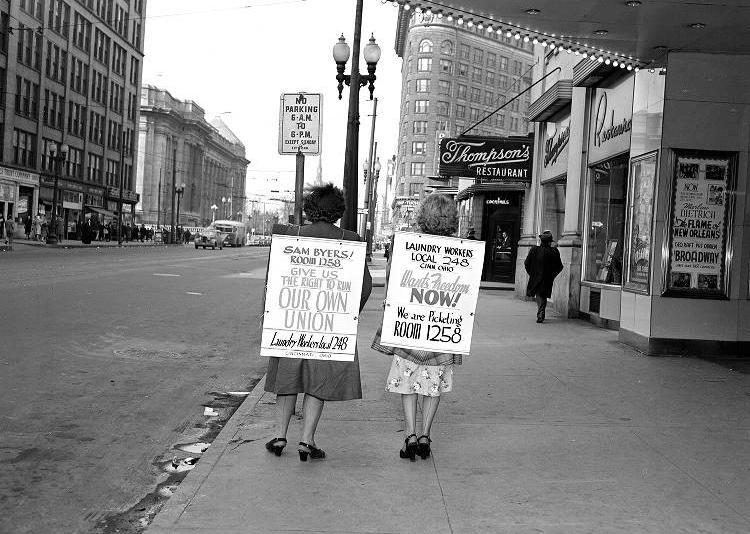By the early 20th century, Indianapolis had become headquarters for several national and international unions and the center of operations for such legendary labor leaders like Samuel Gompers, John L. Lewis, William L. “Big Bill” Hutcheson, William Green, and Daniel J. Tobin. Indianapolis’ central location and its elaborate rail system made the city more accessible to the rest of the country than most cities. At least 12 major unions selected Indianapolis for their headquarters, thus establishing the city as the “labor capital of America” by the early 1900s.

The roots of organized labor activity in the city can be found as early as June 1850, when Indiana artisans founded the Mechanics Mutual Protections. The group sought increased wages, better educational opportunities, and security for families of members unable to work because of illness. In November 1865, advocates for an eight-hour workday met in Indianapolis to launch a statewide movement. , president of the local Machinists’ and Blacksmiths’ Union and future president of the international union (1870), led the effort. Delegates representing various Indiana unions convened in Indianapolis in April 1873 and founded a trades assembly to promote the interests of laborers statewide. Another meeting on September 8, 1885, resulted in the organization of the Indiana Federation of Labor, led by Samuel L. Leffingwell. In 1903 it affiliated with the American Federation of Labor.
By the 1880s Indianapolis reportedly was one of the largest union cities in the nation with nearly 10,000 union members. The 1880 census listed 77 labor unions in the state, most represented in Indianapolis, with the constituting the largest group. In July 1880, local unions formed the Indianapolis Trades Assembly (known as the Indianapolis Central Labor Union after 1883), which comprised 83 locals and 11,000 members by 1892. This high degree of labor activity attracted many national and international unions to Indiana’s capital city.

One of the earliest national unions to locate in Indianapolis was the Journeymen Stonecutters’ Association of North America. Around 1875 the union established its headquarters at 8 East Market Street and remained until ca. 1968 when it merged with the Laborers’ International Union of North America, headquartered in Washington, D.C. The Brotherhood of Locomotive Firemen (organized 1873) maintained headquarters in Indianapolis from 1876 until 1880 when it relocated to Terre Haute.
Typographical Union No. 1, organized in 1852 as part of the National Typographical Union to represent pressmen, typesetters, and others in the printing trades, remains as one of the oldest unions in the city. The national union, which became the in 1869, moved its headquarters from New York City to Indianapolis in 1888. It acquired the Van Camp mansion at 2820 North Meridian Street in 1925 for its new offices, staying there until 1961-1962 when it moved to Colorado Springs, Colorado.
The American Federation of Labor, founded in Columbus, Ohio, in 1886, moved its headquarters from New York City to Indianapolis around 1894, apparently in retaliation against eastern leadership. AFL president Samuel Gompers kept offices with the International Typographical Union in the old DeSoto Block on East Market Street. He later relocated the federation’s headquarters to Washington, D.C.
Mineworkers comprised one of the largest organized labor bodies in the United States in the early 1900s. On September 8, 1885, union representatives met in Indianapolis and founded the National Federation of Miners and Mine Laborers. After reorganizing as the in 1890, the union selected Indianapolis for its headquarters in 1898, citing the city’s geographical location near the center of the coal-mining region. Under the leadership of John L. Lewis, the UMWA maintained offices on the 11th floor of the in the 1920s. At a January 1934, meeting in , 1,800 UMWA delegates voted to relocate union headquarters to Washington, D.C.
The United Brotherhood of Carpenters and Joiners, organized in Chicago in 1881, designated Indianapolis as its headquarters around 1901. A new building constructed at 222 East Michigan Street in 1909 housed the union’s administrative offices as well as those of the Barbers, Teamsters, and other unions.
The Journeymen Barbers, Hairdressers, and Cosmetologists International Union of America, founded in Buffalo, New York, in 1887, moved from Cleveland to Indianapolis where it remained from 1902 until the late 1970s. Union leaders helped to establish state licensing standards for new barbers and to regulate barber and beauty schools. In 1933 the JBHCIU opened and operated a nonprofit barbers’ and beauticians’ school in Indianapolis.
Several other unions maintained headquarters in Indianapolis at one time. Among them were the International Brotherhood of Teamsters, known as the (1903-1953); the Laundry Workers International Union (? -1930s); International Brotherhood of Bookbinders (ca. 1915); the Bricklayers, Masons, and Plasterers International Union of America (ca. 1905); and the Bridge and Structural Iron Workers Union (ca. 1910).
While unions were principally concerned with building membership in their early years, they gradually became more active in lobbying for national labor legislation. During the 1930s several of the national and international unions left Indianapolis for Washington, D.C., to be closer to the nation’s political activities. Mergers between unions, such as the Journeymen Barbers International Union (the last international union in the city) and the United Food and Commercial Workers, also led to the removal of union headquarters from Indianapolis. Likewise, the long history of antilabor sentiment exhibited by the city’s business leaders may have affected unions’ decisions to leave the city. Indianapolis continued as headquarters for the newly formed Indiana State AFL-CIO following the national merger of the American Federation of Labor and the Congress of Industrial Organizations in 1955, but by the mid-1950s the city had lost its place as the nation’s labor capital to Washington, D.C.

Help improve this entry
Contribute information, offer corrections, suggest images.
You can also recommend new entries related to this topic.